There are 29 Companion plants for watermelon in this list including a variety of Vegetables, Herbs, alliums, and Flowers.
Watermelon is a sweet and refreshing fruit that many people love all around the world. This luscious fruit is an annual crop that is reasonably simple to cultivate, making it a popular choice for both home gardeners and farmers. Watermelon companion plants include beans, maize, and radishes, which can offer additional nutrients to the soil and guard against pests.
Growing watermelon may also be difficult due to pests and illnesses. Aphids, cucumber beetles, and spider mites are common pests that can harm watermelon plants. Companion planting it with herbs like basil, cilantro, or oregano, which repel pests while attracting beneficial insects, will help prevent these concerns.
In this article, we will explore the Good Companions and Bad Companion plants and their effect on watermelons when planted as companion plants.
Table of Contents
Good Companion Plants For Watermelon
Alliums
1. Garlic

Although it may seem like an odd pairing, planting watermelon and garlic together results in a potent partnership that is advantageous to both plants and gardeners. Gardeners may boost soil nutrients, stave off pests, and improve plant health in general by using companion planting.
Garlic’s potent smell deters pests like aphids and spider mites, while watermelon’s deep roots aid with soil aeration and improved drainage. Garlic has sulfur-containing chemicals that have been demonstrated to promote watermelon plant growth and yield.
The farm or garden’s resilience increases when watermelon and garlic are planted together. Gardeners can lessen their reliance on hazardous pesticides and herbicides, resulting in a healthier and more sustainable growing environment, by diversifying their crop mix and utilizing natural pest management techniques. The coexistence of various plants can also aid in drawing useful insects, such as pollinators and predators, that support the ecosystem’s balance and sustain a healthy population of flora and fauna.
2. Leeks
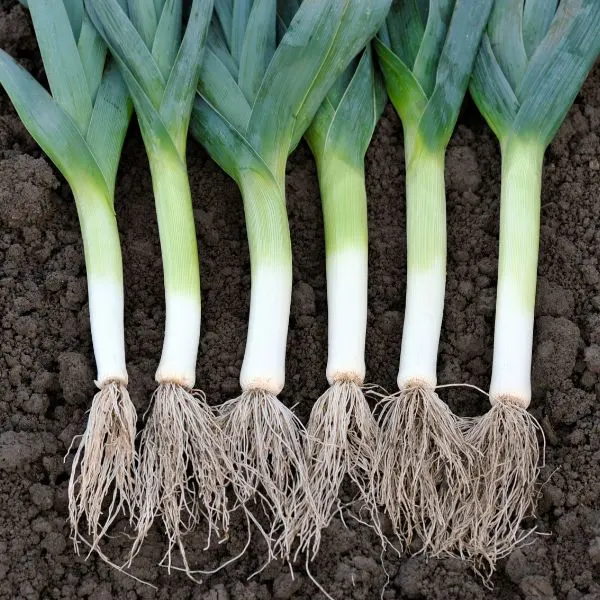
Watermelon and leek companion planting may be a game changer for gardeners and backyard gardeners looking to boost crop health and productivity. You may get several benefits from combining these two crops, including enhanced soil nutrients, fewer insect infestations, and greater overall resilience. Leeks and watermelons go well together because leeks fight pests such as onion flies and nematodes while also enhancing soil structure and nutrient availability. At the same time, watermelons may provide natural ground cover, aiding in moisture conservation and soil protection.
Furthermore, growing Watermelon and Leeks together is good since watermelons require a lot of nutrients and water to thrive, which leeks can give through their deep root systems and nutrient uptake. Leeks have a natural tendency to attract beneficial insects, which can aid in pest management and decrease the need for toxic chemicals. Gardeners should expect to notice an improvement in total production and crop health as a result.
3. Onions
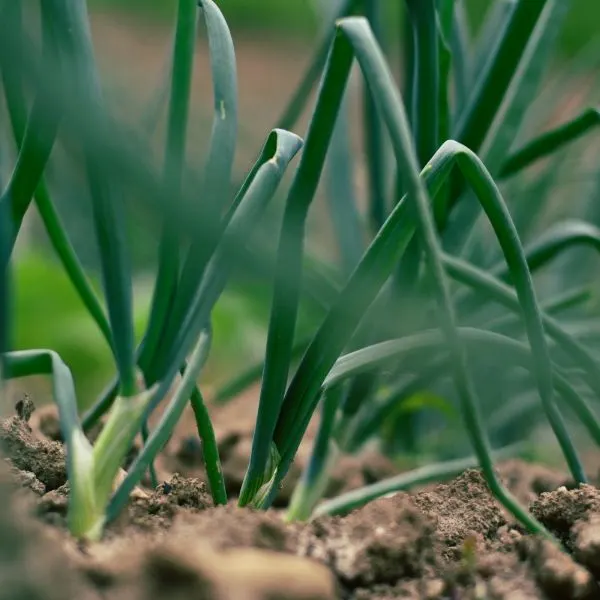
Watermelon and onion companion planting is a really beneficial method for both gardeners and backyard gardeners. It not only improves soil fertility by lowering the chance of soil-borne illnesses and pests, but it can also result in higher yields, healthier plants, and overall crop resilience.
Planting onions alongside watermelons can function as a natural repellent to pests like aphids and beetles, which might otherwise wreak havoc on your garden.
Furthermore, Watermelon and Onion companion planting is advantageous since watermelons require enormous amounts of nutrients and moisture to flourish, which onions can give through excellent soil nutrient uptake and moisture conservation.
Furthermore, watermelon vines may operate as natural ground cover, shielding the onions’ roots from the strong heat and keeping the soil wet. Gardeners should expect to notice an improvement in total production and crop health as a result.
4. Shallots
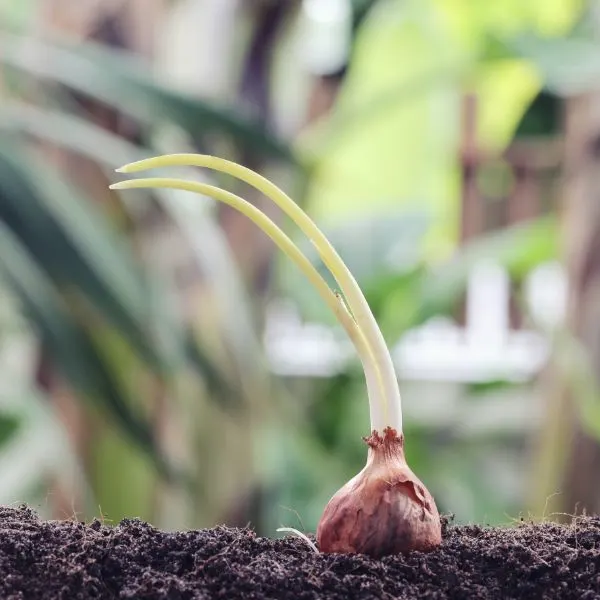
Watermelon and Shallot companion planting may be a game changer for gardeners and backyard gardeners trying to optimize their harvest while boosting the overall health of their crops.
You may get several benefits from combining these two plants, including enhanced soil nutrients, fewer insect infestations, and greater overall resilience.
Shallots and watermelons complement each other well because shallots have inherent pest-repelling characteristics that can help protect watermelon plants from dangerous insects.
Furthermore, watermelons require adequate moisture and minerals to grow, which shallots may give through their deep root systems and nutrient absorption.
Again, shallots are recognized for improving soil quality and structure, which can lead to stronger watermelon plants and larger harvests. These two plants may work together to produce a harmonic growth environment that supports and feeds each other.
Flowers
5. Coneflowers
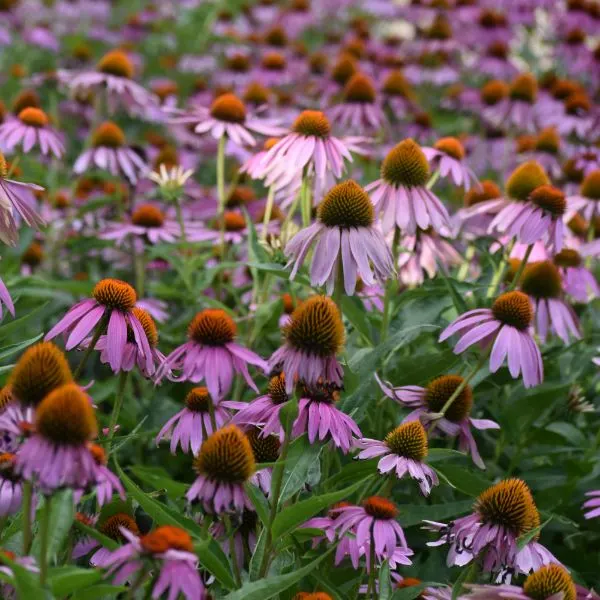
Watermelon and Coneflower companion planting can give a variety of benefits for gardeners and backyard gardeners. Coneflowers, often known as echinacea, have long been utilized to support immune system function.
They can attract beneficial insects such as bees, butterflies, and predatory wasps that prey on plant pests in the garden. They also create substances that resist pests, like Japanese beetles and aphids, decreasing the need for chemical pesticides.
Coneflowers, when combined with watermelons, can assist in increasing the general health and resilience of your garden. They have deep taproots that may break up compacted soil, boosting both plant water and nutrient intake.
They also fix nitrogen in the soil, which can aid in naturally fertilizing the watermelon plants. Furthermore, the coneflowers’ vivid and colorful flowers may add beauty and intrigue to your landscape, providing a visually beautiful show.
6. Coreopsis
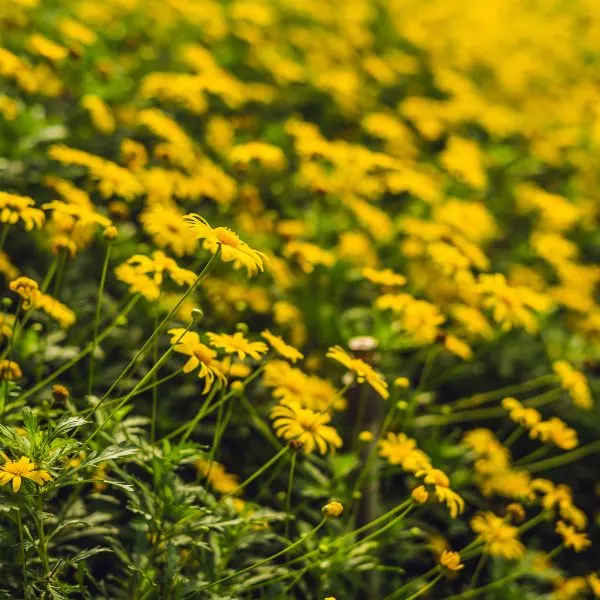
Watermelon and Coreopsis are ideal companion plants for gardeners and backyard gardeners. The Coreopsis attracts beneficial insects such as ladybugs and lacewings that eat pests such as aphids. At the same time, the watermelon acts as a living mulch for the Coreopsis, holding moisture and keeping the soil cool. This combination has the potential to improve soil fertility, minimize the need for chemical pesticides, and boost crop output.
Furthermore, Coreopsis is a lovely decorative flower that may add to a garden’s visual beauty while giving several advantages to the Watermelon plant. The yellow or pink blooms of Coreopsis bloom all summer, bringing a splash of color to the landscape. They can also assist in attracting pollinators like bees, which are necessary for the watermelon to produce fruit when planted near it.
7. Cosmos
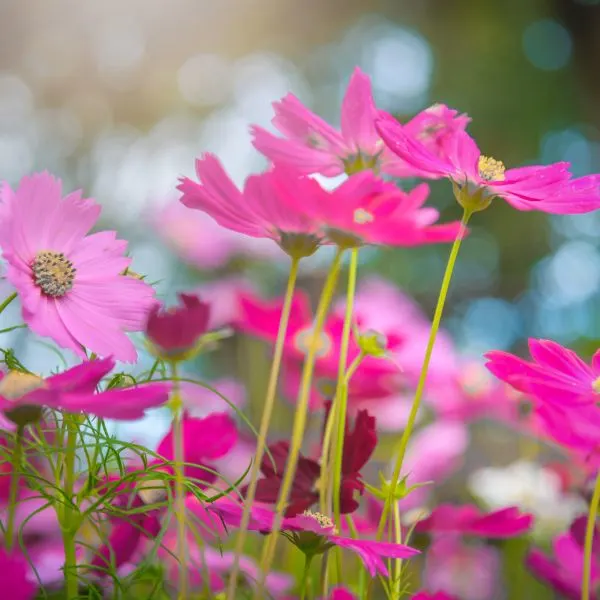
Watermelon and cosmos make excellent companion planting for both gardeners and backyard gardeners. Planting these two crops together can improve your garden’s overall health and production. Watermelon, a delightful and refreshing summer fruit, thrives in warm and sunny circumstances, whereas the cosmos invites important pollinators to the garden with its colorful and vibrant blossoms.
One of the most notable advantages of watermelon and cosmos companion planting is that cosmos functions as a natural pest repellant, keeping hazardous insects away. With its lovely blossoms, the cosmos contributes to the garden’s charm and can serve as a colorful backdrop to the watermelon vines. Furthermore, watermelon vines shade the soil, reducing weed development and maintaining soil moisture, making it a great partner for the cosmos.
When growing watermelon and cosmos, ensure both plants have enough area to develop and thrive. Watermelon vines may rapidly become invasive, providing enough space for the cosmos to grow and thrive alongside them. Planting cosmos as a border around the watermelon crop or sprinkling between the plants is a nice technique.
8. Marigolds
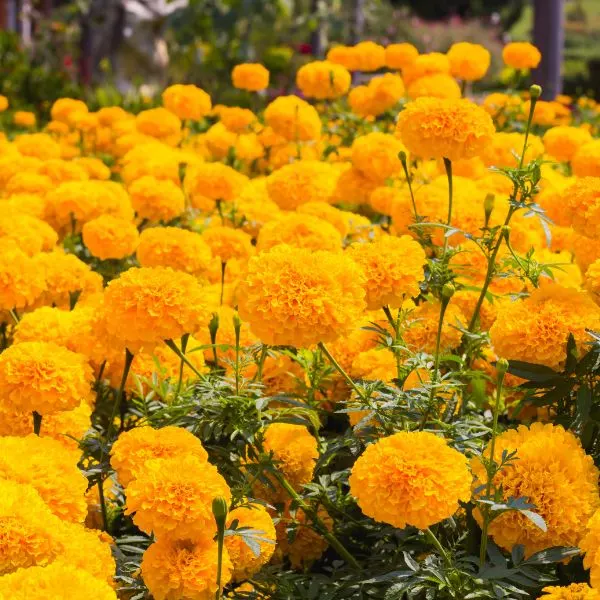
Watermelon and Marigold companion planting is a wonderful method for gardeners and backyard gardeners hoping to enhance crop productivity and improve the general health of their land. Marigolds are well-known for repelling dangerous insects like nematodes, which may cause substantial damage to watermelon crops. Furthermore, marigolds can attract helpful insects like ladybugs, which can feed on other pests that might harm watermelon plants.
One potential disadvantage of combining watermelon and marigolds is that marigolds can create a chemical that inhibits the development of some plants, including watermelon. However, this is often not a serious concern because the advantages of pairing these two plants outweigh any potential drawbacks.
Marigolds should be planted around the edge of the watermelon crop rather than directly in the same bed to maximize success. By doing so, the marigolds can continue to give their positive properties without hindering the watermelon’s growth.
9. Nasturtiums
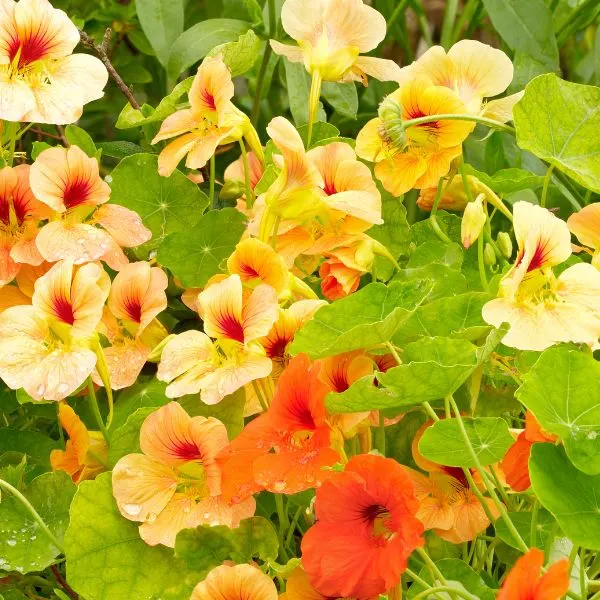
Watermelon and Nasturtium companion planting may be a game changer for gardeners trying to enhance crop health and yield. Nasturtiums have a strong odor that repels pests such as aphids, whiteflies, and squash bugs, all of which are major enemies of Watermelon plants. Nasturtiums are also known to attract helpful insects, such as ladybugs and hoverflies, which hunt detrimental insects and boost pollination rates. This symbiotic connection reduces the need for pesticides and other chemical treatments, resulting in a healthier and more sustainable garden.
Furthermore, Nasturtiums are natural soil builders, removing excess nutrients and reducing erosion. This procedure supplies the soil with critical nutrients such as phosphorus and potassium, which are required for Watermelon plant growth and development. Furthermore, Nasturtiums grow quickly and will cover any bare soil spots, limiting water loss via evaporation and retaining soil moisture.
10. Sunflowers
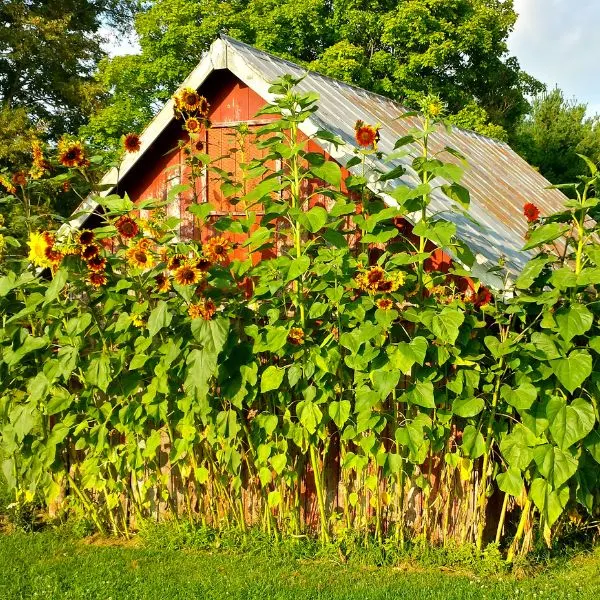
Watermelon and sunflower companion planting is a wonderful approach to improving the health and production of your garden. This powerful combination provides gardeners and backyard gardeners with a variety of benefits, including higher soil fertility, fewer insect infestations, and greater overall resilience.
Sunflowers are recognized for their capacity to attract pollinators such as bees and butterflies, which may boost your watermelon crop yield. Furthermore, the tall and robust sunflower stalks support the expansive watermelon vines, limiting the possibility of injury or breaking.
Furthermore, the thick roots of sunflowers can improve soil structure by allowing water and nutrients to penetrate deep into the soil where they are most required. Watermelon plants with stronger roots and larger yields may benefit from this. Sunflowers also contain allelopathic substances, which can impede the growth of some weeds, improving your garden’s health.
Herbs
11. Catnip
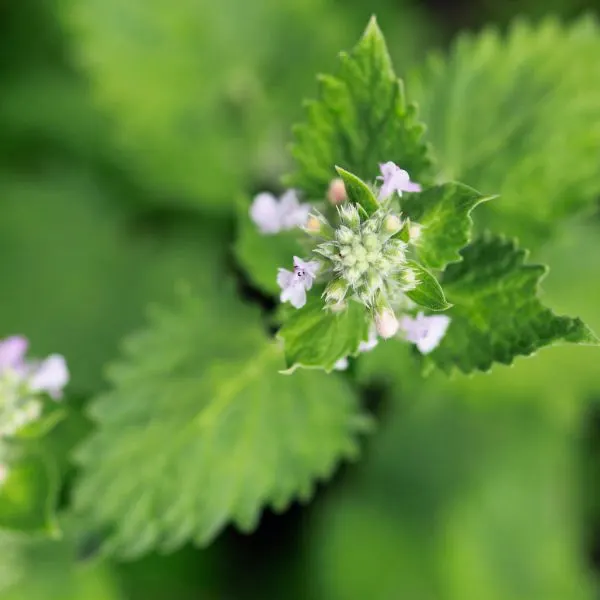
Watermelon and catnip companion planting can bring several benefits to gardeners and backyard gardeners. These two plants can collaborate to improve crop health and productivity by enhancing soil nutrients, minimizing insect infestations, and improving overall garden or farm resilience. Catnip is a nutrient-dense plant that can enhance soil health while supplying watermelon with a broader spectrum of nutrients required for development and production.
Furthermore, catnip is believed to repel pests that might harm watermelon plants, such as aphids, cucumber beetles, and squash bugs. This reduces the need for chemical pesticides, resulting in a healthier and more sustainable garden. Furthermore, catnip attracts helpful insects like bees and butterflies, which pollinate watermelon blossoms, resulting in more fruits.
12. Chamomile

Watermelon and chamomile companion planting can provide several benefits to gardeners and backyard gardeners. When planted together, these two plants can work together to improve crop health and productivity by enhancing soil nutrients, minimizing insect infestations, and improving overall garden or farm resilience. Chamomile is a nutrient-dense plant that may supply watermelon with a broader spectrum of nutrients required for development and production.
Chamomile is also recognized for its pest-repelling characteristics. Chamomile includes natural pesticides that can help repel pests, including aphids, spider mites, and squash bugs, all of which are harmful to watermelon plants.
This reduces the need for chemical pesticides, resulting in a healthier, more sustainable garden. Furthermore, chamomile attracts beneficial insects such as ladybugs and hoverflies, which can aid with pest management and pollination.
13. Chives
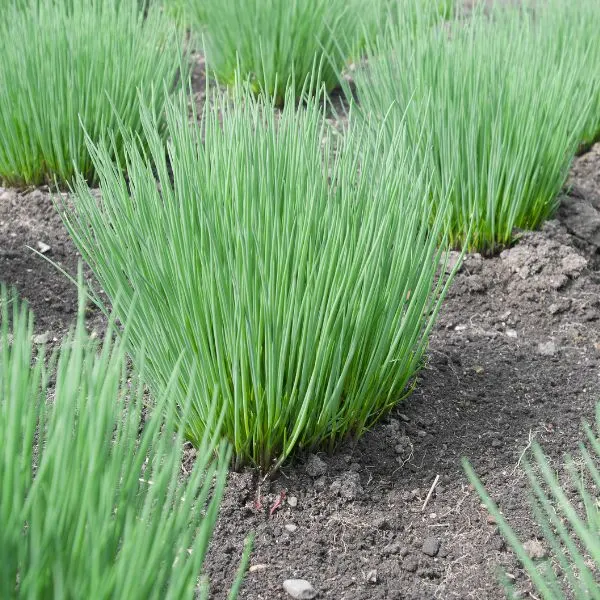
Gardeners and backyard gardeners may reap several benefits from companion planting watermelons and chives. This method not only creates an aesthetically beautiful and diversified garden, but it can also improve crop health and output.
The combination of watermelon and chives can boost soil nutrients since chives are a nutrient-rich plant that can improve soil health. As a result, the plant gets access to a greater spectrum of nutrients, which can boost watermelon development and output.
One of the distinct advantages of planting watermelons and chives together is that their development tendencies are complementary. Watermelon is a wide plant that takes up a lot of areas, but chives grow vertically, adding a vertical element to the garden.
This implies they may be planted beside one another without competing for space or resources. To maximize success, ensure that the watermelon plant receives adequate sunlight and water and that the chives are kept carefully trimmed to avoid shadowing the watermelon.
14. Dill
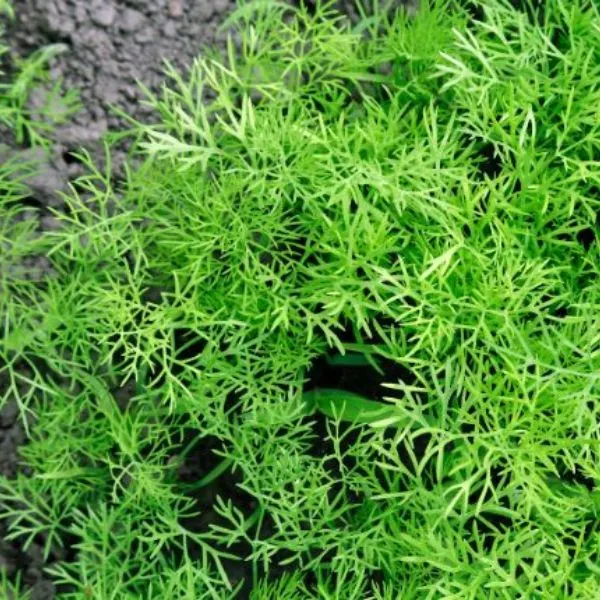
Companion planting is a tried-and-true method that provides various advantages to gardeners and backyard producers. Among the many successful combinations, Watermelon and Dill have shown to be an excellent match, providing several benefits to both crops. Gardeners may improve the health and productivity of their crops while also minimizing the chance of insect infestations by growing these two together.
One of the major benefits of growing Watermelon and Dill together is that their nutritional requirements are complimentary. While watermelon is a heavy feeder with high nitrogen requirements, dill is a natural nitrogen-fixer that can aid in improving the soil with this critical nutrient.
This symbiotic relationship produces healthier, more robust plants and decreases the need for synthetic fertilizers, making this a more sustainable and ecologically beneficial approach.
15. Lavender
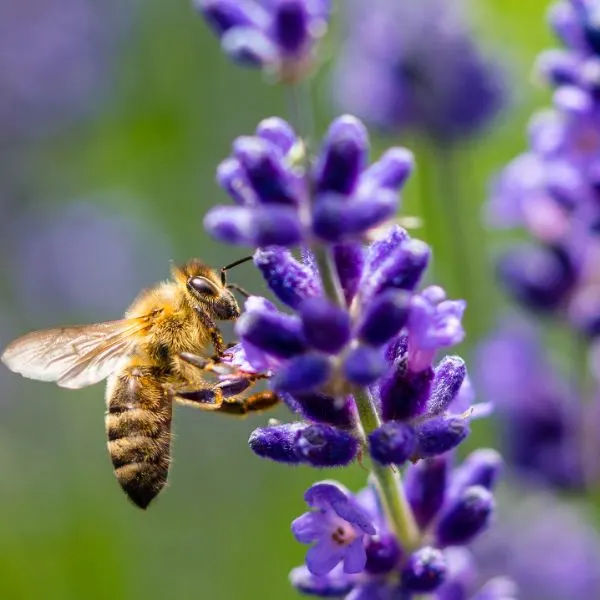
Companion planting is an old strategy that benefits gardeners and backyard farmers in various ways. When it comes to crop combination, Watermelon, and Lavender are an excellent match, providing several benefits to both plants. Gardeners may boost the health and productivity of their crops while also creating a healthy and diversified garden environment by growing these two together.
One of the most notable advantages of Watermelon and Lavender companion planting is that Lavender’s aromatic blossoms attract pollinators such as bees, butterflies, and hummingbirds, which are essential for a Watermelon fruit set. Furthermore, the root system of Lavender can assist in enhancing soil structure, increasing drainage, and avoiding soil erosion, resulting in a healthier growth environment for Watermelon plants.
16. Marjoram
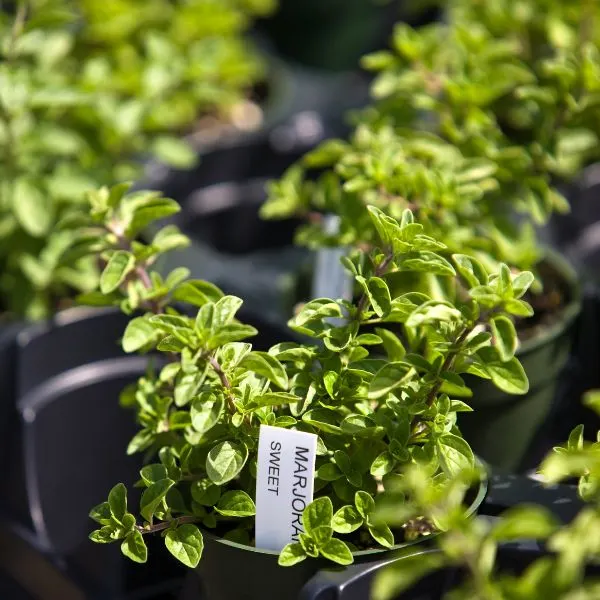
Companion planting is an old strategy that may provide many benefits to gardeners and backyard producers. Among the many suitable combinations, Watermelon and Marjoram are an excellent match, providing several benefits to both plants. Gardeners may boost their crops’ health and productivity while encouraging a flourishing and balanced garden ecology by growing these two together.
One of the most notable benefits of Watermelon and Marjoram companion planting is that Marjoram’s thin root system can aid in avoiding soil erosion and enhance soil structure. Furthermore, the leaves of Marjoram are abundant in critical elements like calcium, iron, and vitamins A and C, making it a good natural fertilizer for Watermelon plants. Gardeners may improve the soil and produce healthier, more vigorous plants by interplanting Marjoram with Watermelon.
17. Mint
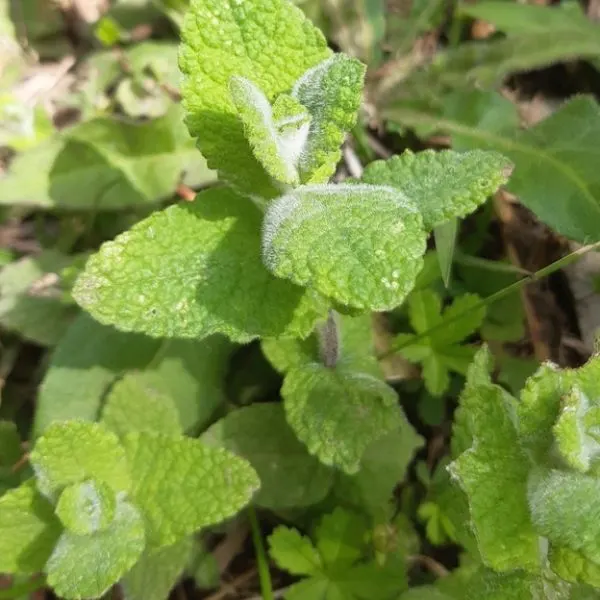
Planting Watermelon and Mint together is a successful strategy that has many advantages for gardeners. Mint’s deep roots improve soil fertility and structure, providing essential potassium and warding off pests like aphids, flea beetles, and squash bugs. Mint flowers attract beneficial insects for natural pest control, and planting them together fosters a thriving garden ecosystem.
18. Oregano
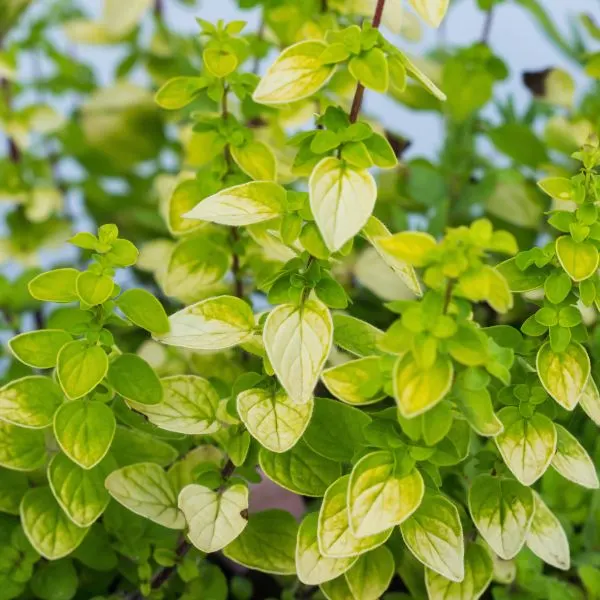
Partner planting A powerful pairing for any garden is watermelon and oregano. Oregano is a great plant to grow alongside watermelon because of its potent scent and natural oils, which deter many common garden pests, including aphids, spider mites, and cucumber beetles.
The thin roots of oregano aid in the retention of soil moisture, and its capacity to fix nitrogen enhances soil fertility. Make sure the oregano has enough room to develop by planting it beside the watermelon plants or along the garden bed’s edge.
Oregano is a useful culinary herb that may lend a flavorful kick to salads, grilled meats, and sauces, in addition to its pest-repelling abilities. Its blossoms draw benevolent creatures like bees and butterflies, which helps to create a healthy garden environment. It’s crucial to consider both plants’ development tendencies when growing watermelon and oregano together.
Watermelon plants need a lot of areas since they spread out rapidly, so make sure there is adequate space for both plants to grow successfully. Overall, gardening enthusiasts who want to boost their harvest output while fostering a healthy garden environment may consider planting watermelon and oregano together.
19. Rosemary

For gardeners and backyard gardeners, pairing watermelon with rosemary can provide a number of advantages. Because it naturally repels insects, rosemary can keep pests away from the watermelon. Furthermore, the scent of rosemary may draw helpful insects, such as bees and butterflies, which will aid in pollinating the watermelon plants.
Additionally, by boosting soil fertility and preventing soil erosion, rosemary can aid in enhancing soil quality. Weeds can compete with watermelon for nutrients and resources. Hence it has been demonstrated that it can effectively inhibit them.
20. Sage
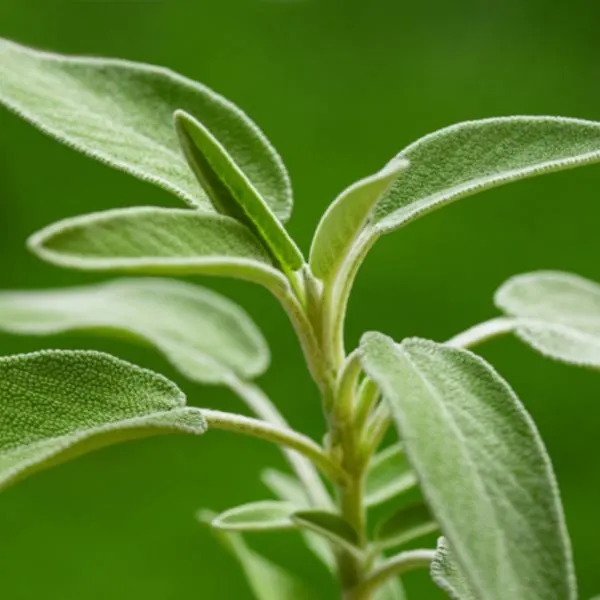
Watermelon and sage companion planting is a great strategy to increase your garden’s output and health. No matter what amount of experience a gardener has, they will all be impressed by the myriad advantages this synergistic collaboration produces. When cultivated together, watermelon and sage offer each other support and defense against pests and diseases, strengthening and fortifying the ecosystem of the garden. Sage’s natural pest-repelling qualities will help protect your prized watermelons from pests, and watermelon plants can give shade and much-needed moisture to the sage.
21. Thyme
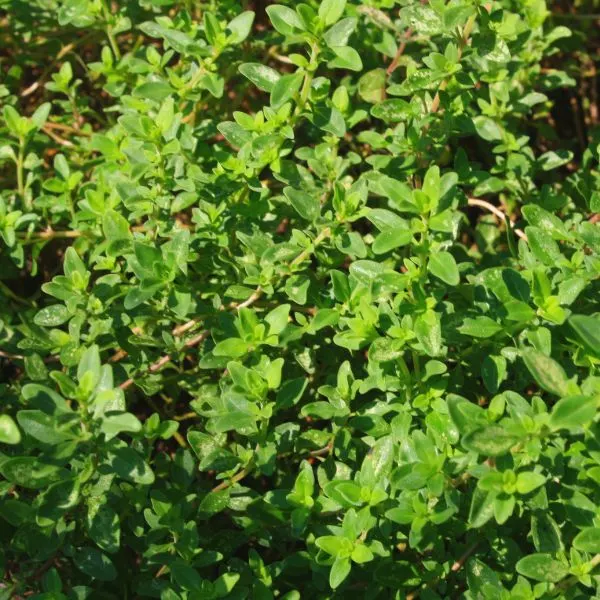
A watermelon and thyme companion planting is a potent pairing that can up your gardening game. You can get a variety of advantages from combining these two plants that will make your garden flourish.
The ability of thyme’s natural insect-repelling capabilities to shield your watermelon plants from pests is one of the pairing’s most important benefits. Thyme is a great natural insect defense for your watermelon plants because it emits a powerful aroma that can confuse and scare away bugs.
The ability to boost soil health and nitrogen levels is another advantage of cultivating watermelon and thyme together. Thyme is a low-maintenance plant that can survive in nutrient-deficient soil, unlike watermelon plants which are heavy feeders and need a lot of nitrogen.
Thyme can aid in nutrient breakdown, and the creation of a more balanced and nutrient-rich soil environment as watermelon plants take nutrients from the earth up. As a result, the two plants develop a mutually beneficial relationship that improves production and the general health of your garden.
Vegetables
22. Beans

For gardeners and backyard producers, pairing watermelon with beans is a marriage made in heaven. The symbiotic interaction between these two plants can assist in strengthening the soil, boosting crops, and fending against pests.
Beans’ capacity to fix nitrogen in the soil makes them one of the major advantages of watermelon and bean cultivation together.
Watermelon plants’ growth and fruit production depend critically on the nutrient nitrogen. You can establish a self-sustaining system by planting beans close by. The beans fix nitrogen in the soil, which watermelon plants can use for growth and development.
Watermelon and bean planting together also have the added benefit of reducing disease and insect activity. Beans produce natural defenses against pests like aphids and spider mites. Watermelon plants are particularly susceptible to these pests, so companion planting is a great all-natural defense.
Beans can also aid in the suppression of soil-borne pathogens like Pythium and Fusarium, resulting in a more robust and disease-resistant garden environment.
23. Broccoli
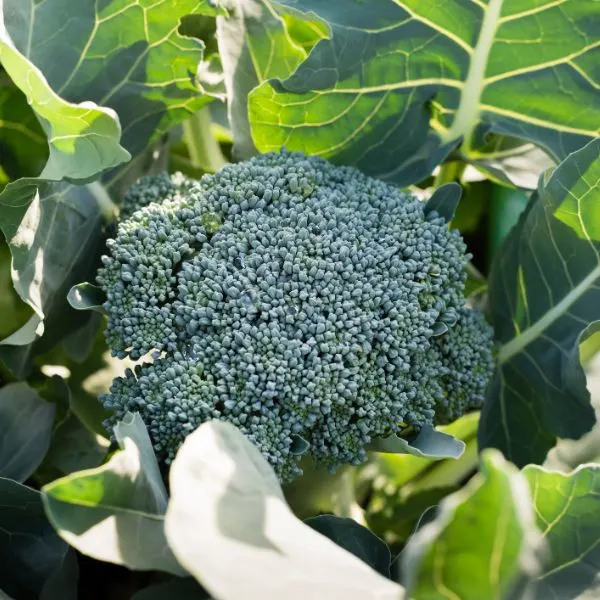
Gardeners have used the time-tested practice of companion planting for generations, and watermelon and broccoli go together like bread and butter. These two crops can be grown together for a variety of reasons, and the results are remarkable. These two plants work in harmony to improve soil quality, increase crop yields, and keep pests from wreaking havoc.
Two crops with complimentary nutrient needs are watermelon and broccoli. While broccoli thrives in soil that is rich in phosphorus and potassium, watermelon is a heavy feeder that needs a lot of nitrogen. Together, they can reduce the risk of overfertilization by the broccoli absorbing extra nitrogen from the soil and providing the watermelon with the nutrients it needs to grow robust and healthily.
24. Carrots

Planting watermelons and carrots together can help prevent insect infestations and boost soil quality. Root maggots frequently attack carrots, which can cause severe crop loss.
Planting them near watermelon, on the other hand, can assist in discouraging these pests since watermelon emits a chemical that repels them. Watermelon’s aroma can help hide the scent of carrots, making them less appealing to pests.
Watermelons and carrots should be planted together at the correct time and in the proper area to get the most advantages. Gardeners should put the watermelon and carrots in well-drained soil in a position that receives lots of sunshine.
They should also avoid planting them too close together, which might lead to nutritional and space competition. By following these tips and best practices, gardeners can enjoy a bountiful harvest of nutritious, delicious watermelons and carrots.
25. Corn

Watermelon and corn companion planting is an excellent strategy to increase output and health in your garden. These two crops are a perfect combination since their nutritional requirements are complementary.
Watermelon is a heavy feeder that needs a lot of nitrogen, but corn is a tall, leafy plant that might benefit from the watermelon vines’ support. Watermelon vines may climb over corn stalks when planted together, creating a natural trellis that helps to maximize space utilization.
Planting watermelon and maize together can also assist in enhancing soil quality. Corn is a high-carbohydrate crop that generates a lot of carbon-rich material that may be composted and utilized to enhance the soil.
Conversely, watermelon is a source of nitrogen that can aid in boosting maize development. Gardeners may build a symbiotic relationship between these two crops by planting them together, resulting in healthy, thriving plants.
26. Okra

Watermelon and okra companion planting is a wonderful approach for gardeners and backyard gardeners to boost the health and productivity of their crops. Watermelon may benefit from the nitrogen-fixing capabilities of okra while giving shade and moisture to the okra plants, which is one of the many advantages of companion planting. Furthermore, the okra’s deep root system might aid in softening the soil, which is good for the shallow-rooted watermelon plant.
Furthermore, companion planting can help prevent insect infestations, as okra acts as a natural repellant to bugs that might harm watermelon crops. This improves the garden’s or farm’s overall resilience, minimizing the need for toxic pesticides or insecticides.
Planting okra alongside watermelon can also assist in enhancing soil nutrients because the decaying okra leaves and stems can release nitrogen and other necessary elements back into the soil, which the watermelon plants can absorb.
27. Radishes
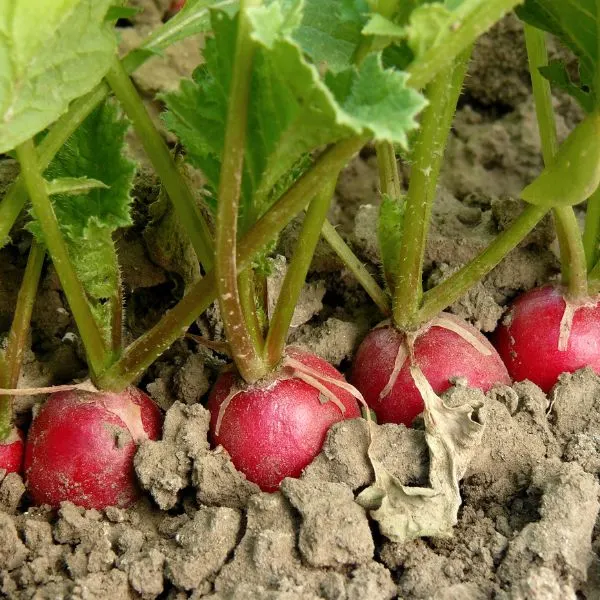
Gardeners and backyard producers might benefit from companion planting watermelons and radishes. These two plants have a symbiotic connection that can aid in enhancing soil health, preventing pests, and improving crop health and production.
One of the primary advantages of growing watermelon and radishes together is that radishes may function as a natural insect repellant. Radishes generate chemicals that repel cucumber beetles, a common insect that can harm watermelon plants. Planting radishes adjacent creates a natural barrier that can aid in the protection of your watermelon crop.
Another advantage of growing watermelon and radishes together is that radishes may help loosen up compacted soil. Radishes have a taproot system that may reach deep into the soil, assisting in soil compaction and improving drainage.
This is especially beneficial for watermelon plants, which need well-drained soil to grow. Furthermore, radishes are a fast-growing crop that may be picked early, giving watermelon plants more room and resources to thrive.
28. Shallots
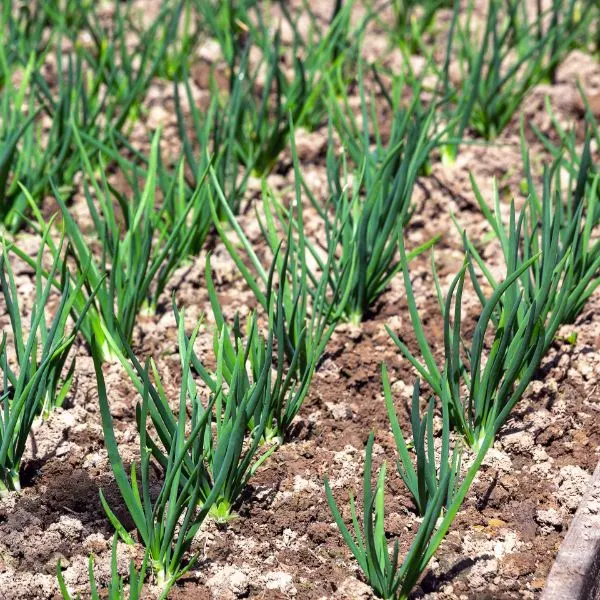
Gardeners and backyard producers might benefit from companion planting watermelons and shallots. Shallots are an onion family member, and as such, they release substances into the soil that can help repel pests and enhance soil health.
Planting shallots alongside watermelon can help to keep pests like aphids and spider mites away from the plants. Furthermore, shallots can assist in improving soil fertility by contributing organic matter and minerals.
One distinct advantage of growing watermelons and shallots together is that their root levels differ, which can assist in reducing resource rivalry. Watermelon has deep taproots, whereas shallots grow shallow roots. This implies that the two plants may coexist and compete for water and nutrients, resulting in a healthier and more productive garden.
29. Spinach

Watermelon and spinach may be planted together to get several benefits in your yard. Watermelon plants grow quickly and take up a lot of areas, making them an excellent companion for low-growing Spinach plants.
The Spinach plants can aid in shading the soil, keeping it cool and wet, which is vital for the good growth of the watermelon. Furthermore, the roots of spinach can improve soil health by boosting nutrient availability for both plants. Watermelon plants can also benefit from the allelopathic substances found in spinach, which prevent pests and illnesses.
One of the most notable benefits of growing Watermelon and Spinach together is that it can boost the overall production of both crops. The combination of these two plants can aid in the creation of a microclimate that benefits both of them.
Spinach may function as a living mulch, inhibiting weed growth and requiring less weeding. Simultaneously, the Watermelon plants provide a natural trellis for the spinach, avoiding the need for extra support structures. When harvesting, the spinach can be harvested sooner to provide room for the growing Watermelon fruits.
Bad Companion Plants for Watermelon
Vegetables that affect watermelon
When growing watermelon, there are potential hazards linked with growing certain vegetables alongside it. Cabbage, kale, and mustard greens can attract pests such as aphids and flea beetles, both of which can kill watermelon plants.
Cauliflower and potatoes may compete for nutrients and water with watermelon, thereby limiting both crops’ development and output. Pests that attack watermelon plants can be attracted by cucumbers, peppers, tomatoes, and zucchini.
Watermelon plants are shaded out by pumpkins and winter squash, which reduces their development and output. In order to guarantee the highest potential development and productivity for all plants, it is important to consider these hazards when developing a garden.
Flowers That Affect Watermelon
It is essential to be aware of the potential hazards connected with growing particular crops together while developing a garden.
Planting watermelons with roses can attract pests like aphids and compete for soil minerals and water. Sunflowers, on the other hand, can shade out watermelon plants and attract insects.
Finally, walnut trees emit a harmful toxin that can destroy watermelon while competing for minerals and water. Watermelon should be planted away from roses and walnut trees, while sunflowers should be given plenty of room.
FAQs
What can I put around my watermelon plant?
In order to grow great watermelons, you’ll need to put a barrier between the watermelons and the ground. This is to reduce the risk of rot and disease. Good ground barriers are straw or even cardboard.
Which fertilizer is best for watermelon?
For watermelon plants, using nitrogen-based fertilizers at the onset is a good idea. Once the melon plants start flowering, however, you should switch to feeding the watermelon phosphorus and potassium-based fertilizer. Watermelons need ample potassium and phosphorus for optimal melon production.
How do you increase watermelon flowering?
If you choose to use chemical fertilizers, apply a fertilizer that contains more nitrogen than phosphorus and potassium, promoting leaf and vine growth. But after flowering begins, fertilize a second time with a low-nitrogen fertilizer that encourages flower and fruit growth.
How do I make my watermelon sweeter when growing?
Heat brings out melons’ sweetness, so make sure to plant them in a location that warms up early in spring and stays hot through the end of September. The south side of a fence or wall is ideal as the structure will absorb heat and light from the sun and reflect it back onto the melons.
When should I stop watering my watermelon?
If it’s wet, let it dry out for a few days and check again. Stop watering the plants altogether about ten days before you harvest the melons. This will allow the sugars in the fruit to concentrate and the flesh to stay crisp. This makes for a much better-tasting watermelon.
How many months does it take for a watermelon to ripen?
It’s typically a range of 80 to 120 days. If you’re growing watermelon from seedlings your bought, just note when flowers open. It typically takes about five calendar weeks for a watermelon to go from flower to ripe fruit.
What is the lifespan of a watermelon plant?
How many watermelons per plant? About 2 to 3 melons can be obtained per plant in its single lifespan of 3-4 months. Usually, gardeners purposely keep only one watermelon per plant to harvest big-sized fruits.
What month is the best time to plant watermelons?
Watermelons need about 100 days of warm weather to produce an edible melon. If the warm, late fall, and winter weather of recent years continue, you may get a watermelon for Christmas. The best times to sow seeds for watermelons are early March and early August.
Should watermelon plants be pruned?
Pruning watermelons promotes healthier vines and increases fruit size. Look for irregular or rotting fruit to prune from the plant. Removing the less-than-perfect melons will enable the plant to focus energy on growing bigger, healthier, juicier melons.
Wrapping up
Watermelon is a well-known fruit produced for its juicy and refreshing flesh. The fruit has a thick skin and flesh that is generally red, pink, or yellow with many seeds. Warm temperatures are required for watermelon plants to grow and thrive. They are often cultivated as annuals and may attain lengths and heights of up to 2 meters.
Watermelon plants demand a warm, sunny area with well-draining, nutrient-rich soil for best development. Watermelon plants require a lot of water, especially during the growing season, to keep from drying up. To stimulate deep root growth, water them well once a week.
Fertilizers can also be applied to the soil to increase growth and production. A soil test before planting can assist in identifying nutrient levels and the amount of fertilizer needed. Watermelon plants require nitrogen, phosphorus, and potassium as macronutrients.
More companions
